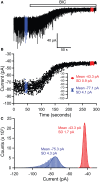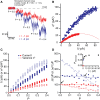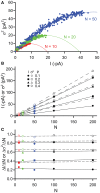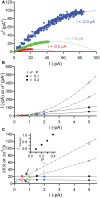Methods for recording and measuring tonic GABAA receptor-mediated inhibition
- PMID: 24367296
- PMCID: PMC3852068
- DOI: 10.3389/fncir.2013.00193
Methods for recording and measuring tonic GABAA receptor-mediated inhibition
Abstract
Tonic inhibitory conductances mediated by GABAA receptors have now been identified and characterized in many different brain regions. Most experimental studies of tonic GABAergic inhibition have been carried out using acute brain slice preparations but tonic currents have been recorded under a variety of different conditions. This diversity of recording conditions is likely to impact upon many of the factors responsible for controlling tonic inhibition and can make comparison between different studies difficult. In this review, we will firstly consider how various experimental conditions, including age of animal, recording temperature and solution composition, are likely to influence tonic GABAA conductances. We will then consider some technical considerations related to how the tonic conductance is measured and subsequently analyzed, including how the use of current noise may provide a complementary and reliable method for quantifying changes in tonic current.
Keywords: GABAA; extrasynaptic; methods; noise; tonic inhibition.
Figures




Similar articles
-
Context-Dependent Modulation of GABAAR-Mediated Tonic Currents.J Neurosci. 2016 Jan 13;36(2):607-21. doi: 10.1523/JNEUROSCI.2047-15.2016. J Neurosci. 2016. PMID: 26758848 Free PMC article.
-
Multiple and plastic receptors mediate tonic GABAA receptor currents in the hippocampus.J Neurosci. 2005 Oct 26;25(43):10016-24. doi: 10.1523/JNEUROSCI.2520-05.2005. J Neurosci. 2005. PMID: 16251450 Free PMC article.
-
Subtype-specific GABA transporter antagonists synergistically modulate phasic and tonic GABAA conductances in rat neocortex.J Neurophysiol. 2005 Sep;94(3):2073-85. doi: 10.1152/jn.00520.2005. Epub 2005 Jun 29. J Neurophysiol. 2005. PMID: 15987761
-
The impact of tonic GABAA receptor-mediated inhibition on neuronal excitability varies across brain region and cell type.Front Neural Circuits. 2014 Feb 3;8:3. doi: 10.3389/fncir.2014.00003. eCollection 2014. Front Neural Circuits. 2014. PMID: 24550784 Free PMC article. Review.
-
Tonic GABA(A) receptor-mediated signalling in temporal lobe epilepsy.Neuropharmacology. 2013 Jun;69:55-61. doi: 10.1016/j.neuropharm.2012.04.003. Epub 2012 Apr 19. Neuropharmacology. 2013. PMID: 22538087 Review.
Cited by
-
GABAB receptors in maintenance of neocortical circuit function.Exp Neurol. 2014 Nov;261:163-70. doi: 10.1016/j.expneurol.2014.05.018. Epub 2014 May 26. Exp Neurol. 2014. PMID: 24873729 Free PMC article.
-
Ectopic Expression of α6 and δ GABAA Receptor Subunits in Hilar Somatostatin Neurons Increases Tonic Inhibition and Alters Network Activity in the Dentate Gyrus.J Neurosci. 2015 Dec 9;35(49):16142-58. doi: 10.1523/JNEUROSCI.2853-15.2015. J Neurosci. 2015. PMID: 26658866 Free PMC article.
-
The dynamics of GABA signaling: Revelations from the circadian pacemaker in the suprachiasmatic nucleus.Front Neuroendocrinol. 2017 Jan;44:35-82. doi: 10.1016/j.yfrne.2016.11.003. Epub 2016 Nov 25. Front Neuroendocrinol. 2017. PMID: 27894927 Free PMC article. Review.
-
Decreased surface expression of the δ subunit of the GABAA receptor contributes to reduced tonic inhibition in dentate granule cells in a mouse model of fragile X syndrome.Exp Neurol. 2017 Nov;297:168-178. doi: 10.1016/j.expneurol.2017.08.008. Epub 2017 Aug 16. Exp Neurol. 2017. PMID: 28822839 Free PMC article.
-
Luteolin inhibits GABAA receptors in HEK cells and brain slices.Sci Rep. 2016 Jun 13;6:27695. doi: 10.1038/srep27695. Sci Rep. 2016. PMID: 27292079 Free PMC article.
References
-
- Abramian A. M., Comenencia-Ortiz E., Vithlani M., Tretter E. V., Sieghart W., Davies P. A., et al. (2010). Protein kinase C phosphorylation regulates membrane insertion of GABAA receptor subtypes that mediate tonic inhibition. J. Biol. Chem. 285, 41795–41805 10.1074/jbc.M110.149229 - DOI - PMC - PubMed
Publication types
MeSH terms
Substances
Grants and funding
LinkOut - more resources
Full Text Sources
Other Literature Sources

